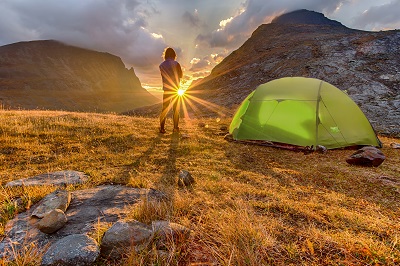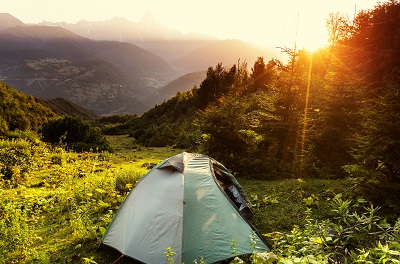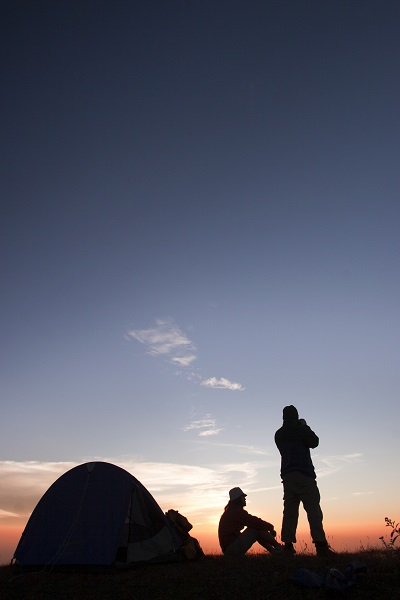How to pick the right tent
You either fall in love with camping, or just won’t get it. To make sure you belong into the former group, we advise you on how to pick the right tent and what to pay attention to while purchasing it.
Before you go to the store, think about the purpose to which you want to use your tent. This determines the appropriate tent frame, weight, size, water column, and of course price.
A person who has never spent a night in a tent might as well never have been alive.
There’s a big difference between using the tent on family vacations at a campsite, on biking tours, or during more demanding hikes. In case of family camping, size is the deciding factor. On biking tours, you need a light tent while resilience and low weight will be appreciated mainly during more demanding hikes.
Once you clear up what you expect form your future tent and what you’ll be most often using it for, picking the right one will be much easier, and purchasing the one that’s most appropriate to you much quicker.
SITUATION NO. 1: I NEED A TENT FOR CAMPING SITES OR BIKING/KAYAK TOURS
-
Choose from hiking tents. Hiking tents are one of the most popular ones, and their supply is quite varied. This category includes family tents, biking tents, kayak tents, campsite tents, or just regular
tents. Each of these subcategories has a different use.
-
If you intend to spend entire days hiking around mountains or riding your bike, pitch your tent quickly at night, in the morning immediately pack it, and resume your journey, then you need a light tent with a resilient frame.
-
While on a family vacation, you need a large tent. If you plan on pitching it at a campsite and leaving it at the same spot for a week or two, you’ll appreciate a simple frame. A more substantial weight won’t be an issue.
SITUATION NO. 2: I WANT A TENT FOR TREKKING/LONG TRAVELS/HARSH CONDITIONS
Choose from expedition tents. Expedition tents have a strong frame with more rods. They’re constructed to withstand strong wind, rain, or mechanical damage. You can often cook inside expedition tents and they provide a nice thermal comfort in winter.
Two-layer, or one-layer tent? Which one is better?
Most modern tents have two layers. This means they have an inner tent and a rainproof outer tent, a so-called flysheet. The reason for this is simple.
The two layers prevent water vapours from condensing inside the tent. Instead, water condenses on the flysheet. There’s enough space between the flysheet and inner tent to allow air to circulate freely and gradually dry out the accumulated water.
The water runs down the flysheet without ever touching the inner tent.
One-layer tents are much more humid and are unsuitable for regular camping. That’s why our range of LOAP tents contains only two-layer tents.
Choosing the tent’s frame: fibreglass, durawrap, or duralumin
The frame affects the tent’s resilience which is why you should pay a close attention to it when you’re choosing a tent. There are 2 types of frames: fibreglass and duralumin. Their use depends on the purpose of your future tent.
Regular hiking tents can perfectly do with simple fiberglass rods. These aren’t as strong and light as duralumin rods, but suffice for standard purposes. Plus, they’re cheaper. You can have either a typical fiberglass frame, or a durawrap one.
Fiberglass rods are known to all camping enthusiasts. They’re connected with a connector which is easy to feel if you drag your finger along the connected rods; it seems to protrude and sometimes scrubs against the tunnels when dragged through the rods. The rods can break if you don’t handle them carefully, and the sharp edges at the breaking point can often damage the tent. A good price is their obvious advantage.
A durawrap frame is also made from fiberglass, but higher quality. There’s a polyurethane foil pressed onto the rods which makes them stronger and prevents the tent from being damaged if the rods break. The connector is placed inside the rods’ body, making the surface of the rods smooth.
Duralumin rods are made from the alloy of aluminium, magnesium, copper, and manganese. They’re very resilient and light which is why they’re included, for example, with expedition tents which need to withstand strong onslaughts of wind and other whims of weather. They’re also suitable if you often fold the tent and pitch it again. Expect a higher price compared to what you’d pay for a fiberglass tent frame.
What’s typical for all types of frames is an emphasis on an easy construction to make sure you don’t have to struggle with the rods for long minutes. Everything’s a matter of practice and experience, but usually a tent can be easily packed within 5 minutes.
The water column of the floor, and pasted-over seams are more important that the water column of the outer tent
Tents are made waterproof by applying a polyurethane layer onto the fabric of the flysheet. This layer keeps the inner tent dry, and you as well. In our climatic zone, the values of the outer tent’s water column can be 1000 mm and higher. No need to overdo it, though. Considering the amount of precipitation in the Czech Republic, 1000-3000 mm will perfectly suffice.
Seams are one of the most troublesome spots, so make sure that the tent’s seams are pasted-over. All LOAP tents have pasted-over seams so that water can’t get inside. What’s more important than the water column of the flysheet is the water column values of the floor. That’s because the greatest pressure is exerted on the floor, for example when you’re kneeling on it. Therefore, the floor’s water column should be at least 5000 mm. This value provides a sufficient comfort, and offers a good price/performance ratio. LOAP tents have floors with an appropriate water column of 5000, and thus are suitable for trouble-free and comfortable camping.
A proper size of your tent guarantees comfort, allows you to cook, and accommodates even bicycles
The size of your tent goes hand in hand with the way you intend to use the tent. A family tent should be spacious so that all family members are comfortable enough and have their luggage at hand.
Cyclists who intend to be leaving from 1 place will greatly do with cyclo-tents. These have a spacious anteroom which can accommodate up to 4 bicycles and allows you to cook. Cyclists will also appreciate the low weight of the tent.
Apart from the number of people who are going to inhabit the tent, you need to also take the size and number of luggage into account.
Here in LOAP we take mainly comfort into account which is why even our 2-people tents have 2 separate entrances. You won’t have to crawl over one another, and will have quality ventilation.
Ventilation and mosquito netting
Ventilation is a necessary part of any tent. It helps to maintain the right temperature and at the same time removes the accumulated wetness which clings to the inner side of the flysheet. It often employs vents – there should be two at least. The best place for vents is at the highest spot of the tent. It should be possible to close the vents from the inside so that rainwater or cold doesn’t get in during adverse weather.
The best ventilation is achieved by opening the entrances. If you have two of them, the air circulation inside the tent will be even better. A good example of LOAP tents with two entrances are Sande, Melbu 3 i 4, Skaun, Tomma, Sunde, Aure. Furthermore, one advantage of covered entrances is that they allow you to air the tent out during rainy weather. You can also facilitate circulation by lifting the bottom hem of the flysheet.
Mosquito netting, which often is a part of entrances, is another indispensable helper. Not only does it prevent pestilent insects from making themselves at home inside the tent, but also facilitates ventilation. If you are deciding between a tent with a mosquito netting and a tent with windows made from transparent plastics, choose the mosquito netting. Tents with plastic windows are quick to dampen, making your stay inside rather uncomfortable.



